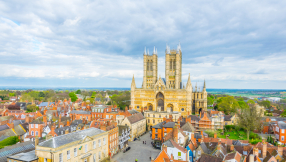If it weren't for the tap, tap, tapping, we could have been in a library. I've never seen such intense concentration. This is a workshop, but Radio 2 is conspicuously silent. What's going on is far too important: this isn't work you can do with half your mind somewhere else.
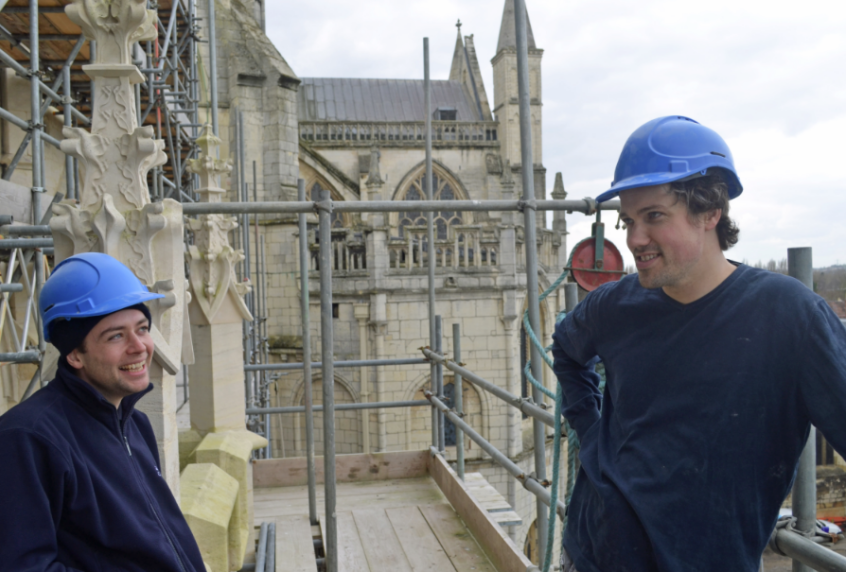
We're in the stonemasons' yard at Gloucester Cathedral, and the sound is the ringing of metal on stone. One of the masons is creating a perfectly smooth angled plane on a stone that will form part of a buttress. With permission, I get in close to take a picture. I don't know if he even registers that I'm there. Another is carving an intricate upright to replace a finial on the cathedral roof, worn and weathered by centuries of wind and rain sweeping across from the Severn.
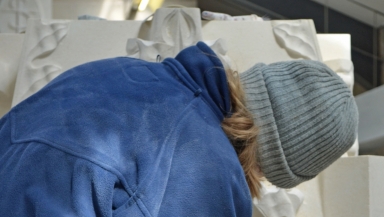
It's an extraordinary place, partly because it's so ordinary. There are half-finished pieces standing around, racks of tools, a giant plan for a piece leaning against a wall – they're drawn out in one-to-one scale before the work begins. In most ways it's a normal workshop.
What makes it different, apart from that intensity of thought and concentration, is that we could have been there six or seven hundred years ago and it wouldn't have looked much different. They'd have worked more by eye, we're told, and some of the techniques would have been different – axes rather than chisels, for instance, in early Norman times – but it would have been basically the same.
I was with Emma Smith, from Ecclesiastical Insurance, a major provider of cover for church buildings which as it happens is based in Gloucester, and two of the masons, James Bayliss and Oliver Chamberlain. And it's Ecclesiastical that's responsible, at least in part, for them being there. With the Worshipful Company of Masons and the Headley Trust, it sponsors the Cathedrals Workshop Fellowship (CWF). Set up initially to offer apprentice stonemasons a career path and a route to higher qualifications, it's now broadened its scope to more trades, with an electrician having graduated in November 2017 and a carpenter and bricklayer joining the latest cohort.
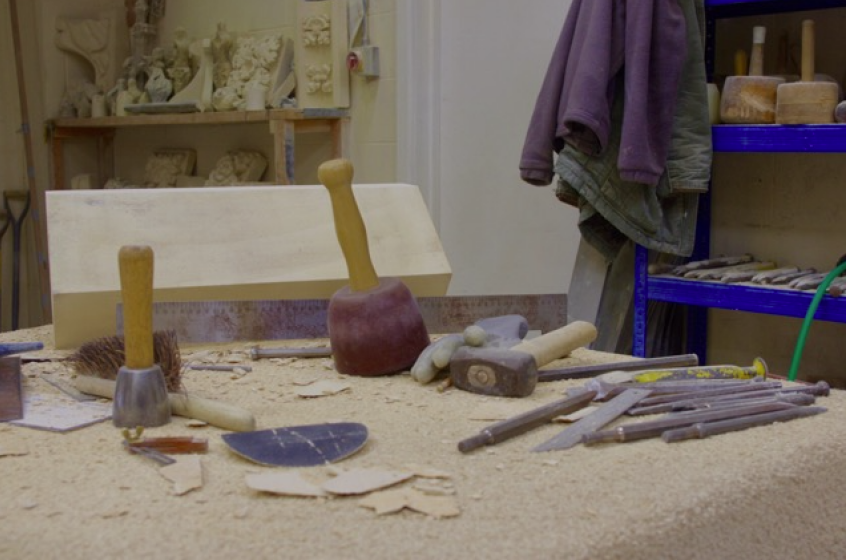
Students work for Foundation Arts degrees in Applied Historic Building Conservation and Repair, offered by the University of Gloucestershire. The idea behind it is to upskill tradesmen in working with ancient buildings, preventing damage and preserving heritage skills. Nine of England's ancient cathedrals – Canterbury, Durham, Exeter, Gloucester, Lincoln, Salisbury, Winchester, Worcester and York – are part of the scheme.
James (33) started training as a primary school teacher but 'soon realised that I wanted to do something more practical'. Previously a landscaper, he went on to become a builder before deciding he wanted to try his hand at stonemasonry. He's now a fully qualified stonemason and CWF graduate. 'The degree is nice to have but the real privilege has been learning so much about my craft and being able to contribute to the conservation of these amazing buildings that are enjoyed by so many people. I really do feel part of a fellowship,' he says.
As well as being thoroughly practical, it's an academically rigorous course. Students cover including ornamental carving, stone selection and geometry, architecture, archaeology, structural engineering and practical conservation techniques.
And as Oliver (31) – still part way through his course – says: 'You have to put the time in. It's a craft – it takes six years to make a useful stonemason.'
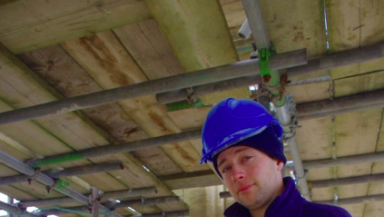
Stonemasons, though, aren't the only people helped by CWF. It's expanded beyond its original remit because it became clear other tradespeople needed help too.
Steve Buchan is the lead electrician at Canterbury Cathedral. He's been there for eight years, and he's seen errors made because people didn't know what they were doing. 'I've seen a lot of mistakes being made by contractors, from fire alarm engineers to plumbers,' he says. 'It's not because they are bad tradesmen; they simply don't understand the fabric of these buildings. They drill through 12<sup>th-century walls that they shouldn't and these kinds of mistakes are irreversible. They are costing us our history.'
He asked if there was a course he could do to learn more about the fabric of cathedrals and churches, and became one of the first non-stonemasons on the CWF programme. He does most of the same modules, like architectural history in a religious setting, but the CWF worked with him to adapt some of the modules so that they would better suit an electrician.
'I think it is fantastic that what was set up as a stonemasons' course has now expanded to embrace other trades, with a carpenter in the latest cohort. That can only be good news for the preservation of heritage skills and the protection of Britain's historical assets,' he says.
Gloucester Cathedral itself has embarked on a 10-year plan called Project Pilgrim, aimed at bringing its heritage to life for the 21st century. As well as work on the fabric and projects linked to the regeneration of the city, it's creating a plaza outside with the cathedral's story told in blocks of carved stone highlighting significant events.
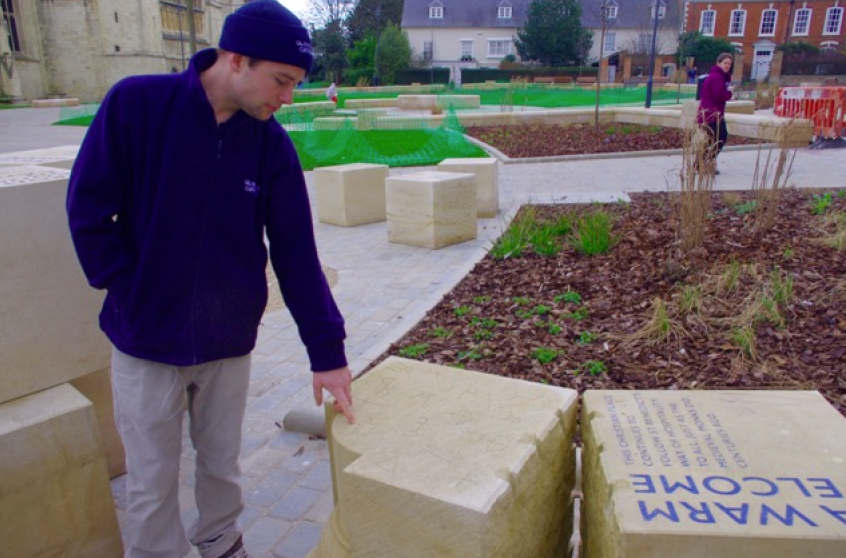
Outside, we climbed to the roof of the Lady Chapel, where James and Oliver have been helping renew the ancient stonework. Across the chapel's roof is the huge bulk of the main structure (these things are enormous). James points out the resident peregrine hunched watchfully on the corner of a tower. And fascinatingly, they show us the marks made by their forerunners, the old craftsmen who created or repaired this masterpiece of architecture during the hundreds of years of its life. Each mason's mark is individual, placed there as a way of taking responsibility for the work – and usually the only memento they leave behind. James and Oliver have their own, and show us where they've left their own marks. In another few hundred years, their successors will see them and show them to ours.
There's a kind of romance about the work that those who labour on these great structures are well aware of. But Britain's cathedrals are not just monuments: with attendance for worship having risen consistently during the last few years, they're one of the few growth areas in the British church. Organisations like Ecclesiastical and CWF aren't just maintaining the fabric of an ancient building; they're contributing to the work of the gospel. It's not too much to say that the stonemasons' yard is helping to build the kingdom of God.
For more about Ecclesiastical's sponsorship of the Cathedrals Workshop Fellowship click here.
Follow Mark Woods on Twitter: @RevMarkWoods













